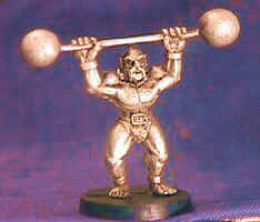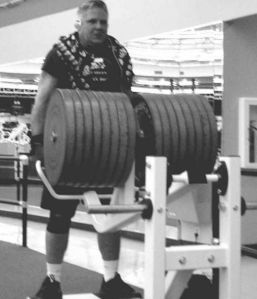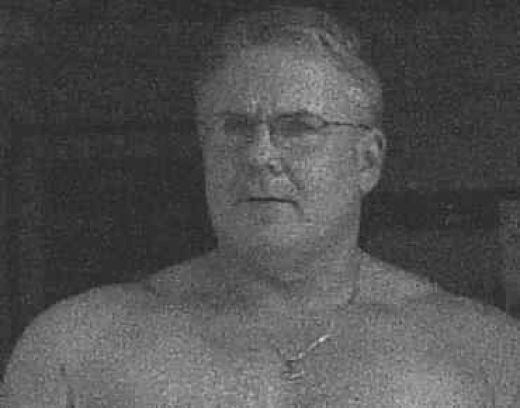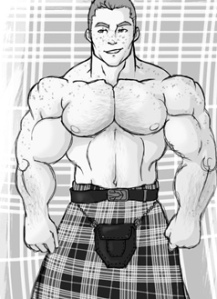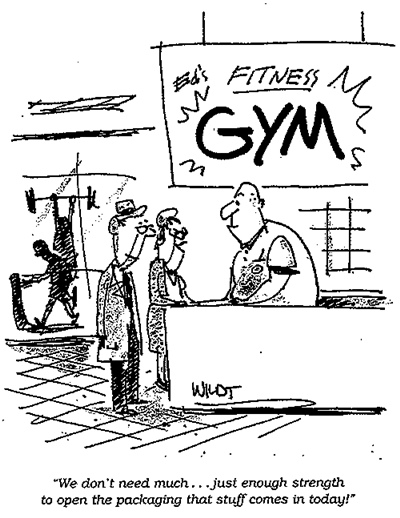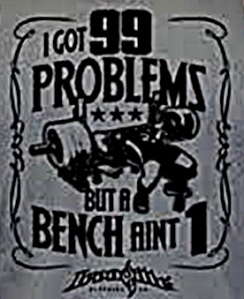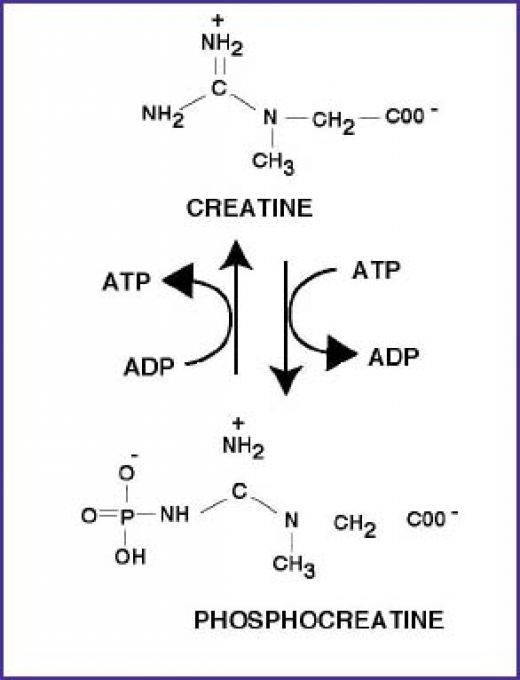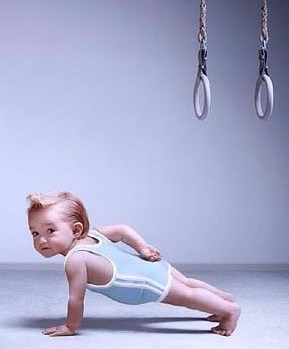Over 40?
I know you’re feeling it —
Man, Mother Nature is working hard on tearing you down, buddy.
I see guys my age in the gym every day, just dragging through their routine workout and looking forward to a long winter’s nap…. no energy, no muscle, no strength.
Their ‘get up and go’ has got up and went.
Seems like time and nature has conspired against them–
And yep…..
It’s hard to hold on to the muscle mass you’ve already got,
…………. never mind build new muscle.
So- how’s it done?
In this exciting episode, we’ll discuss that very subject.

I was talking to a guy who happens to be a Doctor as well as a bodybuilder —
(who’d a’ thunk, huh?) —
—- the other week at the gym,
(I DO talk to people sometimes…. I just try not to make it a habit’s all…..
…. ‘specially when they’ve got a fancy Mercedes Benz and all, but, oh well.. )
He had this very tight spin on building and keeping muscle that I thought was very well put together and worth sharing with all y’all (all two of you…).
Despite the fact that he spends most of his gym-time trying to do that whole bodybuilder 4% body-fat thing,
…. and I don’t care about anything that doesn’t make you stronger,
we often swap notes about supplements, techniques…
I guess it helps we were both Navy men, even though he was in the Officer class,
…. and I was in the other one… ( the one that did all the work ) .
But I digress.
From his perspective (and MINE),
building muscle is directly dependent on all of the following factors being in place:
the intensity AND duration of muscle tension (pushing heavy weights -80% 1RM- reps to failure),
the quality and availability of the right nutrients (we’re fixin to talk more about this….),
an anabolic hormonal environment (free testosterone, Hgh, Insulin, cortisol levels),
rest,
and, in a slightly different context, gender and age.
It’s interesting how some people don’t realize how difficult it is to keep these things in balance…
… but it’s essential if one is GAIN muscle after a workout instead of just breaking it down for fuel.
(that is: being Anabolic instead of Catabolic.)
Sure, there’s nothing complicated at all about lifting weights….
although I bet a lot of folks think that doing a lot of reps at a light weight is the same as less reps with more…. (NOPE),
or that 1 rep at maximum is better (EVEN MORE NOPE)
or that lifting weights ain’t even necessary if you take certain Anabolic chemicals (THAT’S JUST BEING A DOPE)………………….
………… so. let’s deal with these ideas first.
High reps with low weights is almost exactly the same as only doing cardio…
which is great if you’re looking for a slim, streamlined physique…
(You’ve come to the wrong place there, Mary….)
but is absolutely worthless in adding pounds of good, strong, Alpha-Male muscle.
And while doing 1 rep Maximums will certainly make you stronger (FOR 1 REP),
it is also likely to tear, break, strain, detach, bruise, sprain, contuse, traumatize, or otherwise mess up some or all of the one precious corporial body you’ve got –
—- while still ending up looking like the guy who gets thrown out of Cici’s Pizza for eating too much of their really crappy cardboard ‘pizza’. (Ewwww.)
Now, about Anabolic substances: their action can be explained best in this way:
they do not so much BUILD muscle, as PREVENT muscle from being catabolized during and after a workout.
The end result is MORE MUSCLE…
but, only if there’s a reason for the muscle to grow… and that’s WHY YOU WORK OUT..
…. you tear the muscle fibers down, and the body uses proteins, carbs and stored fats to rebuild them – instead of the ready fuel of catabolization: existing muscle.
In other words, you can take as much Winstrol, Superdrol, Masteron, Trenbolone, Halotestin, Anadrol, Halotosis, Spongebobalone, or Bigusol as you want –
—- you won’t get much bigger or stronger if you don’t work out hard.
Here’s where it gets interesting for you guys over 40.
As you progress through your 30’s and 40’s, your serum levels of testosterone – (THE hormone necessary for building muscle ), starts to decline.
This decline is gradual, but it soons become noticable in several ways – a loss of libido, a paunch around your mid section, a decline in energy and brain function.
Sure, you can say.. “oh well… that’s life“; and let nature take away any studliness you may or may not have possessed in the past….
…… or you can take matters in your own and your Doctor’s hands.
The first step is to go to your local sports medicine Doctor and have your T-Levels checked.
These levels should somewhere between 300 and 600…
….. any lower, and your chances of buildling new muscle is very slim, and you’re gonna start losing the muscle you got already.
If the levels are indeed low, the Doc may want to give you a shot to see if he can boost them, or he may give you a scrip for synthetic T to get back to normal.
Or he may tell ya not to worry about it, “it’s a natural part of aging”.
If so, get another Doctor.
‘Cause whether it is, or whether it ain’t, we aint ready for the geezer house yet.
If you don’t like Doctors (and who does) there are several over the counter products that can boost T-levels, if you suspect yours are lacking..
….. but get the test done, even if you got to send away for it.
It’s worth knowing where you’re at on this.
Availability of the right nutrients refers to the idea that your body requires different kinds of fuel for different activities.
I believe strongly in supplementing before, during, and after intense workouts- as well as first thing in the morning and before bed.
I can work out harder and longer, my recovery time is considerably shortened, thus, I can hit the gym hard four or five times a week.
Every body is a little different…
…… so you may have to tweak this in order to get it right for your own.
In the morning shake, 4 grams BCAA, 5 grams Glutamine, 3 grams HMB, 35 grams Whey Protein, 3 grams Creatine Monohydrate, plus 2 grams Glucosamine/Chondroitin/MSM for your joints, all mixed in fruit juice, plus an morning only group consisting of an ECA Stack, Yohimbe, Saw Palmetto, and a very hard-to-swallow Animal Pack (Vitamins).
45 minutes pre-workout, the same minus the simple Creatine, plus 3 grams Creatine Phosphate, 5 grams Arginine-AlphaKetaGlutarate, (or Arginine); or a pre-workout supplement like SMASH, FIERCE, NanoVapor or NOX-CG3 (I love all of these, especially NOX-CG3- but it’s SO freakin expensive, and it tastes like a cross between ink and brussels sprouts.) (Fierce is excellent and very cost-effective.)
Add some coffee and some ECA about 30 minutes before….
I like to have a handful of mixed nuts and raisins as a snack then too.
During workout, 64 oz Carb drink plus 5-10 grams BCAA’s, 5-10 grams chewable Glutamine.
Post workout, the same as morning shake minus any Creatine, minus ArginineAlphaKetaGlutarate, plus 3 grams Cissus Quadreangularus, 3 grams Vitamin C, 3 grams Vitamin E, and some simple carbs for recovery.
Before bed, the same as morning except 35 grams of slow-digesting Protein instead of Whey, and no ECA stack.
Don’t miss your Glutamine here- it’ll work all nite long to boost your Hgh levels… which means faster growth and recovery!
Meals: now, I know what the experts say, and I agree, I guess….
But I don’t know how ANYBODY has the time to eat 6 or 7 times a day, or how they don’t go to flab eating all that food… I couldn’t, can’t, and don’t.
I stay under 2500-3000 calories a day; I eat five times a day (not including my daily shakes)
Breakfast: mostly protein (eggs), some carbs (biscuit), no fats that I can help.
Lunch: fruit or a muffin… maybe some fast-carbs like Raisin Bran, Rice Crispies, (dry) etc.
Dinner: preferably salmon, tuna, chicken, turkey or lean beef – plus rice, noodles or pasta – mostly protein, moderate slow carbs, some healthy fats.
The other meals are fruit or salad.
No butter- no hydrogenated or solid fats at all if they can be avoided.
Olive oil in everything that needs added fat- even cake! (use 2/3 of the amount called for and EVOO works great!)
But, my metabolism is admitedly very slow… you’ll probably need much more food than this. (If I ate 6000 calories a day, I’D be the guy at Cici’s).
I think the essential idea of meals for me is to have enough carbs in my system to fuel about 2/3 of my workout, and then run on burning fat to finish the weight training and then thru 30-45 minutes cardio.
That’s why the BCAA’s and Glutamine are added to the workout carb drink – to give me additional support… and it is VERY effective.
Finally, REST.
Again, I know I’m a jerk, but I don’t get guys who think that one or two workouts a week will cut it.
One guy who does that was telling me one day that he was worried about “overtraining”…. I had a hell of a time keepin my big trap shut, I can tell ya.
You can overtrain, sure.
But not by lifting 35% 1RM for 20-30 reps twice a week…..
……. and you sure as hell aren’t serious about building any muscle.
If you DO work hard and often, then REST/RECOVERY becomes very important; so important that the fact is that your muscles do not grow when you’re working out: they only grow when you are at rest, as a result of you working out.
It’s like planting a garden…
You plant a tomato plant, you give it water, and plant food, and good dirt, and sunshine, and if all that shit comes together right, all you got to do is sit back and watch it grow, and pretty soon, you got so many friggin tomatoes that you’re tryin to give em away to anybody who’ll take em off yer hands. (They ARE very good for you, you know…)
I mentioned gender and age; these ARE considerations.
For instance, did you know that 75% of people over the age of 68 cannot lift 10 pounds over their heads? 10 pounds???
That shows you how much muscle is lost after the age of 40…
Doesn’t seem fair somehow, does it?
Just when you’re startin’ to figure out how everything works, you don’t have the strength left to throw the switch, or you’ve shrunk so much you can’t reach the damned switch. And there’s only one thing that will slow that down: weight training.
Of course, the over-40 strength trainer is at a disadvantage, but with hard work and dedication, he can overcome nature’s cruel little shrinking joke…. and Little Elvis will work MUCH better, too! (The above mentioned arginine won’t hurt in that respect, either!. You don’t have to take my word for weight training improving the over 40’s quality of life (and sex), there are plenty of studies out there.
As far as gender goes, that is also a factor to consider…
Obviously women (or maybe, HOPEFULLY would be a better word) have less testosterone (and other anabolic natural substances) to help them avoid catabolic states, but it’s been proven that a diet low in high glycemic index carbs, high in protein, combined with medium intensity cardio and 50-65% 1RM weight training will induce good increases in overall strength and endurance.
That means a firm, well rounded beautiful bod that will look great anywhere you go, and hell… what’s wrong with that, girls?
Huge muscles on girls look like hub caps on a Bentley anyway.
( This is where some of you girls send me an email calling me a misogynist, sexist jerk…. well, consider it sent. Thanks anyway. I’ll have to be frank, though… you being mad at me is the least of my present concerns …. I’m not any of those things, (ok- maybe a jerk..) but you can think what you want……….. I don’t train women anymore, anyway. )
Well, that’s it fer now.
I hope you got something out of it.
Drop me a line and lemme know how you’re doing.
HOY!
(Note: this post and any other posts of mine are strictly for entertainment purposes only, and are not to be taken as medical advice or any other kind of advice for that matter… see your own doctor before entertaining any ideas of using any of this entertainment for your own entertainment. If you’re a minor, supplements aren’t for you.. you’ve still got growth issues and bone development things, and this stuff could interfere with all that and mess you up good….. , and you shouldn’t be reading this blog anyway, so don’t read another word…… just go get some exercise – play some ‘find the weasel’ with Sara Jane, play football or baseball – or if all else fails, Nintendo- but get off the Internet. Get it? Good.)
<


